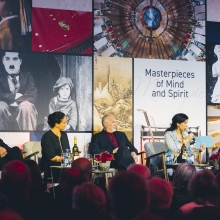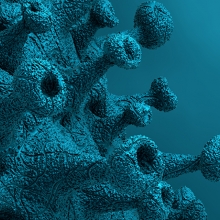Chiral encounters
Briefs

Chemists have borrowed the phrases “left-handed” and “right-handed” from anatomy to describe molecules that are characterized by a particular type of asymmetry. To explore the concept of chirality, look at your hands, palms up. Clearly, the two are mirror images of one another. But try as we might to superimpose them, they will never overlap completely. Such objects, termed “chiral,” can be found at all scalesin nature, from galaxies down to molecules.
We experience chirality every day, not only when we grab an object or put on our shoes, but also when we eat or breathe: our senses of taste and smell can distinguish two mirror images of a chiral molecule. In fact, our body is so sensitive to chirality that a molecule can be a medicine in one form, and a poison in its mirror image. Chirality is thus crucial in pharmacology, where 90% of synthesized drugs are chiral compounds.
Chiral molecules are also important for investigating fundamental phenomena inphysics. In a recent collaborationbetween Prof. Nirit Dudovich of the Institute’s Department of Physics of Complex Systems and Prof. Yann Mairesse from CNRS/Bordeaux University in France, scientists used chirality to shed new light on one of the most intriguing quantum phenomena: the tunneling process. The findings appeared in the journal Physical Review X.
Tunneling is a phenomenon in which quantum particles cross seemingly insurmountable physical barriers. Since such motion is impossible via classical mechanics, it can be difficult to grasp an intuitive picture of its dynamics. To create a tunnel in chiral molecules, the researchers exposed them to an intense laser field.
“The electrons of the molecules are naturally bound around the nuclei by an energy barrier,” explains Prof. Mairesse. “You can imagine the electrons as air trapped inside an inflatable balloon. The strong laser fields have the ability to reduce the thickness of the balloon enough for some air to tunnel through it, even though there’s no hole in the balloon.”
The Mairesse and Dudovich teams probed an as-of-yetunexplored aspect of tunneling: the moment in which a chiral molecule meets a chiral light field, and how this brief encounter affects electron tunneling.
The researchers used a laser field that rotated in time to spin the barrier around the chiral molecules. Continuing with the balloon metaphor, if the laser field rotates horizontally, you expect the air to exit the balloon on the horizontal plane, following the direction of the laser field.
What the researchers found is that if the balloon were chiral, the air would exit the balloon flying toward the floor or the ceiling, depending on the rotation direction of the laser. In other words, the electrons emerged from the chiral tunnel with a memory of the rotation direction of the barrier. Prof. Mairesse likens this effect to that of a corkscrew, but at the nanometer and attosecond scales. (An attosecond is a billionth of a second, and it takes only a few hundred attoseconds for an electron to escape an atom or molecule— should a viable tunnel be present.)
The two teams thus discovered that the likelihood that an electron will undergo tunneling, and the timing of the tunneling event, depend on the chirality of the molecule. These exciting results lay the groundwork for additional studies that will use the unique symmetry properties of chiral molecules to investigate the fastest processes occurring in light-matter interaction.
Nirit Dudovich is supported by:
- André Deloro Research School of Physical Science
- Jay Smith and Laura Rapp Laboratory for Research in the Physics of Complex Systems
- Jacques and Charlotte Wolf Research Fund
- Wolfson Family Charitable Trust & Wolfson Foundation
- Robin Chemers Neustein Professorial Chair







